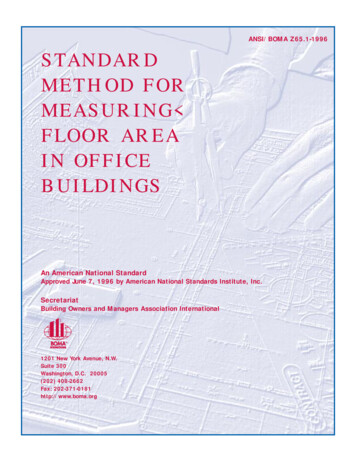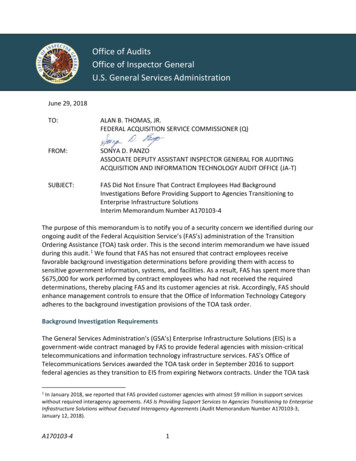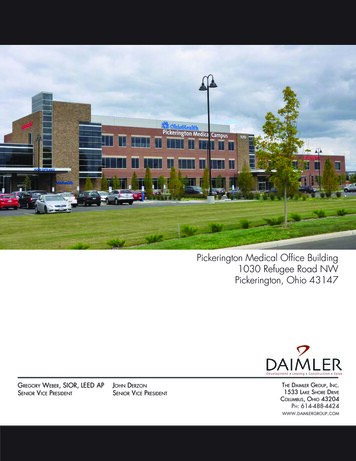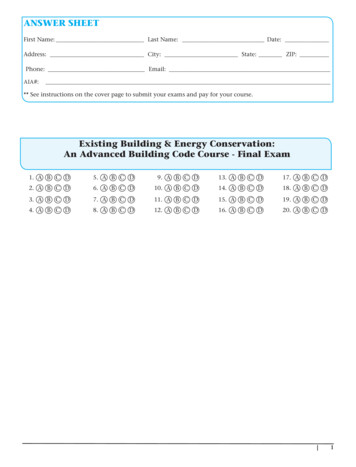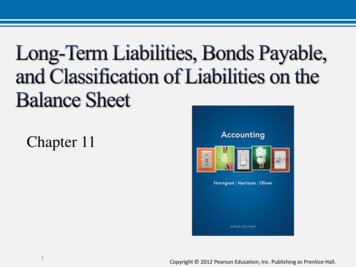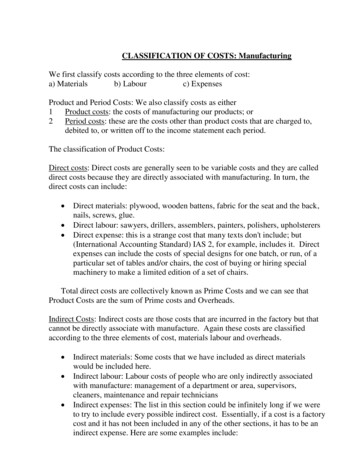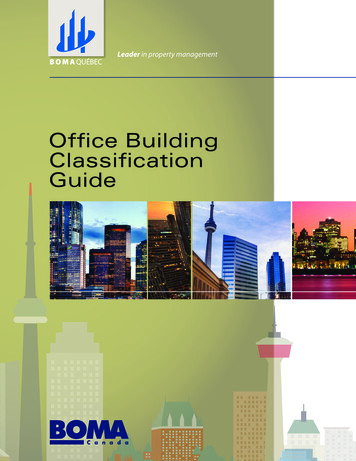
Transcription
Leader in property managementOffice BuildingClassificationGuide
Office BuildingClassification GuideIndex3Project Approach4Introduction5A Guide for Class A, B or C Office Buildings8Conclusion9ReferencesSpecial thanks10Schedule A – Support Grid For Office Building Classification2
Office BuildingClassification GuideProjectApproachThe discussion on the need forclarificationonofficebuildingclassification originated within theBOMA Quebec Property ManagementCommittee. This committee’s missionis to find new ways to improve BOMA’sservice offer to its members. Thusin the fall of 2012 a multidisciplinaryworking group composed of expertsfrom various Quebec-based real estatefirms was formed to study this issue indepth.The working groupincluded the followingexperts:Marie-France Benoit, AltusInSiteChristian Charbonneau, CBRESylvain Leclair, Altus GroupLinda Plante, Ivanhoe CambridgeLinda Rigg, Oxford Properties GroupDominic Saucier, Avison YoungThe main objective of this task force of real estate owners, brokersand appraisers was to come up with an office building classificationframework that could eventually be published on the BOMA Québecwebsite for the benefit of its members.The following document describes in a very simple manner thecommittee’s findings.3
Office BuildingClassification GuideIntroductionBuilding class definitions categorize office buildings asClass A, Class B and Class C. In many markets, Class A can besubdivided into sub-categories such as Prestige, AAA, AA andA. New categories have even started to emerge, such as Class I(industrial converted to office). Commercial real estate agents,owners and managers determine the class of each building. Thegroups consider several factors when determining the differentclasses.The evaluation criteria used to determine a building’sclassification allow the various actors in the commercial officebuilding sector to share a common language and to identifymarket conditions per category, in an organized and readilycomparable manner.Keep in mind that class definition is not a science, as thereare no formal or international standards established. However,the ratings refer to building specifics. The inventory of officespace in a metropolitan market makes a distinction betweenClass A, B, and C buildings.Class B and Class C definitions are based on Class A definitions.A building’s classification is relative to other properties in agiven market. Thus a Class A building in a small town will notshare the same characteristics as a Class A building in the heartof Manhattan.4
Office BuildingClassification GuideA Guide for ClassA, B or C OfficeBuildingsWhat does a Class A Buildingmean? What are the differencesbetween Class A, B and Cbuildings? When looking fornew office space, a tenant willquickly realize most buildingsare classified in one of thosethree categories. The factorsthat determine a building’s classvary in each market, so a ClassA office building in a major urbancity will be much different than aClass A office building in a smallrural town of 30,000 people.There are no definitive formulasused to classify a building, but ageneral definition for each classis provided in the following.5
Office BuildingClassification GuideClass A Buildings:The most prestigious buildings with the most amenities in the best locations. They generally are the most attractive buildings built with the highest quality materials and constructionmethods. Additionally, these buildings usually have a professional manager, good access, andare typically located in highly visible areas on high traffic streets. Due to their exceptional quality, Class A Buildings are usually leased to reputable tenants at the highest rental rates in themarket.Criteria: High-rise building in prime central business district. A flagship building in its market. Architecture - Concrete and steel Security 24/7 – controlled access system,camera monitored. For smaller buildingsor those located in a outlying areas, access control system in place as well asalarm system with off-site monitoring.construction, distinctive design, attractive look, superior exterior finishes onthe curtain wall, superior interior quality finishes in main lobby and commonareas, including elevators and washrooms. Fairly recent construction orvery well maintained and/or recentlyrenovated building. Well designed andgood-size layout to accommodate one orseveral tenants on the same floor. Built by reputable developer and contrac- Strong identifiable location (well knownfessional manager providing centralizedtenant service call system, includingmaximum response time, concierge services, tenant relationship program, regular tenant activities such as barbecuesand holiday breakfasts, new tenant welcome committee, etc.address) - Convenient access (publictransportation, etc.). Managed by a professional firm. Premier tenants. Highest rental rates. Strong market presence. State-of-the-art systems that meet in-dustry standards - automated mechanical, electrical and safety and securitysystems. High capacity back-up powersystem. Elevators - Sufficient number of elevatorstor. Parking - Sufficient private and publicparking to accommodate tenants andvisitors. 24/7 access for building tenantswith security controls in place. Bikestands and electric vehicle charging stations have become the norm. Tenant services – Experienced and pro- Amenities – Enclosed weather protectedwalkway connection, conference centre,fitness centre, service oriented retailsuch as convenience store, cafeteria/food court type restaurants, dry cleaningservices, ATM and Wi-Fi. For stand-alonebuildings not located downtown, cafeteria/food court restaurants and coffeeshops provide above-average services totenants.for the number of floors and building population. Environmental - Certification (BOMA BESt,LEED). Responsable sustainability practicesin place.6
Office BuildingClassification GuideClass BBuildings:Class CBuildings:These buildings are a grade below Class A.Generally, they are slightly older buildingswith good management and quality tenants.It is not uncommon for value-added investorsto target these buildings with the intention ofrenovating them back into Class A buildings.Class B buildings are well maintained overalland quite functional. Class B office buildingscommonly have an acceptable curtain wallfinish, adequate (but not state of the art)mechanical, electrical and safety and securitysystems, and a mid-quality level of interiorfinish. Class B buildings compete for a widerange of users at average rental rates for theirmarket area.This is the lowest grade for useable officebuildings. These office buildings are generally older and may be located on less desirable streets in older sections of the city, forexample. Many of these buildings usuallyhave higher than average vacancy rates fortheir market. Older, less desirable architecture, limited infrastructure and antiquatedtechnology define these buildings. For thesereasons, Class C buildings offer lower rental rates and can be more difficult to lease.Many times these buildings are targeted forre-development. The curtain walls and themechanical, electrical and safety and security systems of Class C building are generallydated, and the quality of finish is often belowaverage. These buildings attract tenants whosign short-term leases for functional space atbelow average rental rates.Criteria: A grade below Class A. Slightly older buildings– Good management, quality tenants. Building finishes– Fair to good. Good quality systems– Not at Class A level. Can be targeted by investors planningrenovations to restore them to Class A.Criteria: Lowest grade for useable office buildings. Older office buildings. Located on less desirable streets in oldersections of the city. Higher than average vacancy rates fortheir market. Well maintained – Functional. Less impressive architecture. Average rental rates. Limited infrastructure. In need of extensive renovations. Obsolete technology. Lower rental rates– may be difficult to lease. Often targeted for re-development. Tenants requiring functional space.7
Office BuildingClassification GuideConclusionThe above descriptions are general guidelinesfor building classifications, although no formalstandard exists. Probably the most importantpoint to remember is that buildings are classifiedrelative to other buildings within their market. Atypical commercial real estate specialist will firstdetermine the Class A buildings in a market bytheir highly desirable locations and amenities,and then classify other buildings in the market inrelation to the Class A buildings.Additional Factors to consider: Floor load capacity. Ceiling height. Improvements to common areas. Nearby services (restaurants, businessclusters, dry cleaning, banks, ATM, etc.). Access (freeway, public transportation).A summary grid including all above-mentionedcriteria for each class can be consulted inSchedule A.This office building classification guide may bereviewed in the future as needed.8
Office BuildingClassification GuideReferences ifications-class-a-class-b-class-c/ or-c-office-buildings-a-guide s/default.aspx http://www.domain-properties.com/domain.cfm?id 40Special thanksProject Leader, drafting of report and grid designLinda Plante, Ivanhoé CambridgePresident, Property Management Committee, BOMA QuébecCo-Project Leader, drafting of reportLinda Rigg, Oxford Properties GroupVice-President, Property Management Committee, BOMA QuébecContributing ExpertsMarie-France Benoit, AltusInSiteChristian Charbonneau, CBRESylvain Leclair, Altus GroupDominic Saucier, Avison YoungProject SupportLinda Carbone, General Manager, BOMA QuébecAnne-Marie Guèvremont, GWLPast-President, BOMA Québec Board of DirectorsBenjamin Shinewald, President, BOMA CanadaNinon Beaunoyer, coordinator - Programs & Events, BOMA Québec9
Office BuildingClassification GuideSchedule A –Support Grid For OfficeBuilding ClassificationClass AGeneral CommentClassification LevelClass BClass CEach building classification is relative to its own market, and criteria may vary from one market toanother. In specific markets, Class A can subdivide into categories such as Prestige, AAA, AA andA. In some cities, a category called Class I (industrial buildings converted to office) is emergingand starting to compete with the more traditional office building classes.Higher LevelLower LevelGenerally, they areslightly older buildingsthat still possess goodmanagement andquality tenants.Older, less desirablearchitecture, limitedinfrastructure andobsolete technologydefine these buildings.They have higher thanaverage vacancy ratesfor their market andleasing them can be achallenge.AgeRecently built projects with themost advanced standards, andvery well maintained older buildingsrenovated on a continuous basiswith up-to-date security and comfortstandards.Recent constructionprojects with minimalrequired standards, andwell maintained olderbuildings.Older office buildingswith minimalmaintenance.Location andAccessGenerally located in the centralbusiness district (CBD) with strongidentifiable location (well knownbusiness address) and convenientaccess (public transit facilities, etc.),offering striking views.Can be located outsideof the CBD or withinthe district of class Abuildings. Their locationis less identifiable.Located on lessdesirable streets inolder sections of thecity.Distinctive and classic design,concrete and steel construction,landmark quality, superior exteriorfinishes for the curtain wall andsuperior interior quality finishesin main lobby and commonareas, including elevators andwashrooms. Well designedlayout to accommodate one orseveral tenants on the same floor.Generally built by a reputabledeveloper.Generic architecture.Curtain wall isacceptable and in somecases the structurecan be apparent.Interior finishes areof average quality. Itis not uncommon forvalue-added investorsto target these buildingswith the intention ofrenovating them backinto Class A buildings.In need of extensiverenovations, manytimes these buildingsare targeted for redevelopment. Thecurtain walls, if any,and the mechanical,electrical and safetyand security systemsof Class C aregenerally dated andthe quality of finish isoften below average.GeneralDescriptionThe most prestigious buildingswith the most amenities in thebest locations. They generallyare the most attractive buildingsbuilt with highest quality materialsand construction methods. Dueto their exceptional quality, ClassA buildings are usually leased toreputable tenants at the highestrental rates in the market.Mid LevelHigh-rise building within primecentral business district. Strongmarket presence.Construction andArchitecture10
Office BuildingClassification GuideSchedule A –Support Grid For OfficeBuilding ClassificationPropertyManagementClass AClass BBest management practices in theindustry, managed by a recognizedprofessional providing on-siteservices such as security, HVAC, airquality, maintenance, tenant workcoordination, local tenant servicesrepresentative, environmentalmanagement, etc.Well maintained withminimal requiredstandards. Notnecessarily on-site staff.Maintenance oftenoverlooked anddeficient.Attract premier, prestigious andfinancially healthy tenants.Compete for a widerange of quality tenants.These buildingscompete for tenantsseeking short-termleases for functionalspace at belowaverage rental rates.The highest rental rates in a givenoffice market.Normally get averagerents for their marketarea.Offer lower rentalrates and can be moredifficult to lease.State-of-the-art systems that meetindustry standards. Automatedmechanical, electrical and safetyand security systems. High capacityback-up power system.Adequate (but not stateof
BOMA Quebec Property Management Committee. This committee’s mission is to find new ways to improve BOMA’s service offer to its members. Thus in the fall of 2012 a multidisciplinary working group composed of experts from various Quebec-based real estate firms was formed to study this issue in depth. The working group included the following experts: Marie-France Benoit, AltusInSite Christian .
